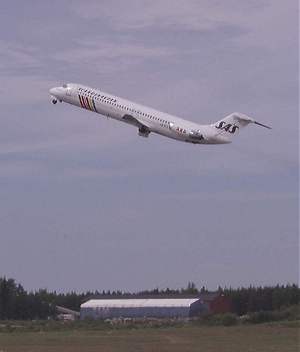6. TAKE OFF.
Tower: Scandinavian 149, wind 060 at 8 knots, you are cleared for takeoff runway 08. Copilot: Scandinavian 149 , cleared for take off.  Advance the throttles to 0.05 EPR below calculated EPR and order SET THRUST. The copilot will adjust the throttles to correct takeoff EPR. Away we go and if nothing unusual happens there will be a call for V1 and ROTATE. In SAS we do not use the call at 80 knots. This was done on F28, that aircraft had no stearing in the foot pedals. When the RP was to fly, LP had to steer the A/C during the initial part of the take off run. At 80 knots, the rudder was effective enough, and the RP could take over. Start rotate the aircraft to approximately 16 degree nose up. Normal time from ground to climb out attitude is 5-6 seconds. Retract the gear as soon as airborne. Climb out with a speed of minimum V2 + 10 and a nose up max 20 degree. At 1 500ft call fore CLIMB THRUST. Continue up to 3 000ft and lower the nose to 1 000ft/min in climb and retract flaps and slats. Accelerate to 250kt (normal speed below FL100) and climb further. All the time our throttles will be at climb thrust setting. That will give us a climb rate of 1 500 to 3 500 ft/min depending on aircraft weight. |
| Go back toFlying the CLASSIC. | Move on toClimb. |